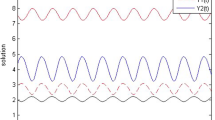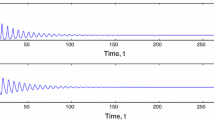Abstract
Following the well-extablished mathematical approach to persistence and its developments contained in Rebelo et al. (Discrete Contin Dyn Syst Ser B 19(4):1155–1170. https://doi.org/10.3934/dcdsb.2014.19.1155, 2014) we give a rigorous theoretical explanation to the numerical results obtained in Bate and Hilker (J Theoret Biol 316:1–8. https://doi.org/10.3934/dcdsb.2014.19.1155, 2013) on a prey–predator Rosenzweig–MacArthur model with functional response of Holling type II, resulting in a cyclic system that is locally unstable, equipped with an infectious disease in the predator population. The proof relies on some repelling conditions that can be applied in an iterative way on a suitable decomposition of the boundary. A full stability analysis is developed, showing how the “invasion condition” for the disease is derived. Some in-depth conclusions and possible further investigations are discussed.


Similar content being viewed by others
References
Bacaër N (2011) A short history of mathematical population dynamics. Springer, London
Bacaër N, Ait Dads EH (2012) On the biological interpretation of a definition for the parameter \(R_0\) in periodic population models. J Math Biol 65(4):601–621. https://doi.org/10.1007/s00285-011-0479-4
Bacaër N, Guernaoui S (2006) The epidemic threshold of vector-borne diseases with seasonality. The case of cutaneous leishmaniasis in Chichaoua, Morocco. J Math Biol 53(3):421–436. https://doi.org/10.1007/s00285-006-0015-0
Bate AM, Hilker FM (2013) Predator–prey oscillations can shift when diseases become endemic. J Theoret Biol 316:1–8. https://doi.org/10.1016/j.jtbi.2012.09.013
Butler G, Freedman HI, Waltman P (1986) Uniformly persistent systems. Proc Am Math Soc 96(3):425–430. https://doi.org/10.2307/2046588
Cheng KS (1981) Uniqueness of a limit cycle for a predator–prey system. SIAM J Math Anal 12(4):541–548. https://doi.org/10.1137/0512047
Conley C (1978) Isolated invariant sets and the Morse index, CBMS regional conference series in mathematics, vol 38. American Mathematical Society, Providence, R.I.
Diekmann O, Heesterbeek JAP, Metz JAJ (1990) On the definition and the computation of the basic reproduction ratio \(R_0\) in models for infectious diseases in heterogeneous populations. J Math Biol 28(4):365–382. https://doi.org/10.1007/BF00178324
Fonda A (1988) Uniformly persistent semidynamical systems. Proc Am Math Soc 104(1):111–116. https://doi.org/10.2307/2047471
Fonda A, Gidoni P (2015) A permanence theorem for local dynamical systems. Nonlinear Anal 121:73–81. https://doi.org/10.1016/j.na.2014.10.011
Garrione M, Rebelo C (2016) Persistence in seasonally varying predator–prey systems via the basic reproduction number. Nonlinear Anal Real World Appl 30:73–98. https://doi.org/10.1016/j.nonrwa.2015.11.007
Hofbauer J (1989) A unified approach to persistence. Acta Appl Math 14(1–2):11–22. https://doi.org/10.1007/BF00046670
Hsu SB, Hubbell SP, Waltman P (1978) A contribution to the theory of competing predators. Ecol Monogr 48(3):337–349
Hutson V (1984) A theorem on average Liapunov functions. Monatsh Math 98(4):267–275. https://doi.org/10.1007/BF01540776
Lakshmikantham V, Leela S (1969) Differential and integral inequalities: theory and applications. Vol. I: Ordinary differential equations. Academic Press, New York, Mathematics in Science and Engineering, Vol 55-I
LaSalle JP (1976) The stability of dynamical systems. Society for Industrial and Applied Mathematics, Philadelphia
Lefschetz S (1963) Differential equations: geometric theory. 2nd edn. Pure and applied mathematics, Vol. VI, Interscience Publishers, a division of Wiley, New York
Rebelo C, Margheri A, Bacaër N (2012) Persistence in seasonally forced epidemiological models. J Math Biol 64(6):933–949. https://doi.org/10.1007/s00285-011-0440-6
Rebelo C, Margheri A, Bacaër N (2014) Persistence in some periodic epidemic models with infection age or constant periods of infection. Discrete Contin Dyn Syst Ser B 19(4):1155–1170. https://doi.org/10.3934/dcdsb.2014.19.1155
Rosenzweig ML, MacArthur RH (1963) Graphical representation and stability conditions of predator–prey interactions. Am Nat 97(895):209–223
Waltman P (1991) A brief survey of persistence in dynamical systems. In: Delay differential equations and dynamical systems (Claremont, CA, 1990), Lecture Notes in Math., vol 1475, Springer, Berlin, pp 31–40. https://doi.org/10.1007/BFb0083477
Wang W, Zhao XQ (2008) Threshold dynamics for compartmental epidemic models in periodic environments. J Dynam Differ Equ 20(3):699–717. https://doi.org/10.1007/s10884-008-9111-8
Yuan Y, Chen H, Du C, Yuan Y (2012) The limit cycles of a general Kolmogorov system. J Math Anal Appl 392(2):225–237. https://doi.org/10.1016/j.jmaa.2012.02.065
Acknowledgements
The author is truly grateful to prof. Fabio Zanolin without whose supervision this work wouldn’t have been accomplished. The author wishes to thank also prof. Carlota Rebelo and prof. Alessandro Margheri for the helpful remarks and even more for suggesting the paper (Bate and Hilker 2013) which introduced our main subject of investigation. Work partially supported by Gruppo Nazionale per l’Analisi Matematica, la Probabilità e le loro Applicazioni (GNAMPA) of Istituto Nazionale di Alta Matematica (INdAM). Progetto di Ricerca 2017: “Problemi differenziali con peso indefinito: tra metodi topologici e aspetti dinamici”.
Author information
Authors and Affiliations
Corresponding author
Additional information
Publisher's Note
Springer Nature remains neutral with regard to jurisdictional claims in published maps and institutional affiliations.
Appendices
Appendix: Disease-free model
The underlying prey–predator system is a standard Rosenzweig–MacArthur model which has already been extensively studied: we refer to Rosenzweig and MacArthur (1963) for the original paper and to Hsu et al. (1978) for the stability analysis. In this Appendix we recall and discuss some known results for sake of clarity in the main dissertation and to show how condition (3) is obtained. The model reads
where the Kolmogorov-like structure has been highlighted.
We identify three equilibrium points: the origin (0, 0), the trivial prey-only equilibrium (1, 0) and a non trivial one \((N^*,S^*)\) which is given by
The Jacobian of system (7) evaluated in the equilibrium points reads
and
The origin is always a saddle. To avoid the stability of the trivial equilibrium it must be
which also ensures
so that the nontrivial equilibrium is unstable if
which is equivalent to (3). Three cases are hence given:
- \(\circ \):
\(m>1/(1+h)\): the logistic equilibrium is stable
- \(\circ \):
\((1-h)/(1+h)<m<1/(1+h)\): (1, 0) is unstable and \((N^*,S^*)\) is stable
- \(\circ \):
\(m<(1-h)/(1+h)\): both equilibrium points are unstable.
Once the last hypothesis (condition (3)) is chosen, the literature ensures that a stable and unique limit cycle bifurcates from the unstable equilibrium \((N^*,S^*)\,\), as reported in Bate and Hilker (2013). We provide a sketch the proof. First of all note that system (7) is dissipative once defined on a set
with k large enough. We could prove that the flow \(\pi \) associated with (7) is uniformly persistent by means of Theorem 2 but this comes straightforwardly from (Garrione and Rebelo 2016, Theorem 3.2(b)).
The existence of the limit cycle comes from the Poincaré-Bendixson annular region Theorem, for which persistence on X is needed, while its uniqueness is proven in Cheng (1981): the stability is a consequence of the uniqueness as shown in Hsu et al. (1978) and in the more classical (Lefschetz 1963). For a general result on the limit cycles of Kolmogorov systems like (7) see (Yuan et al. 2012).
Appendix: Stability analysis
The four equilibria on the boundary pointed out in Sect. 3 are the origin, the trivial logistic equilibrium (1, 0, 0), the disease-free equilibrium \(( N^*, S^*,0)\) and the limit cycle in the disease-free plane that we named \(\gamma ^*\). We choose m as in (3) such that on that plane all critical points are unstable and the limit cycle is stable. We now want to study the stable manifolds of the equilibrium points.
Let us write the linearised matrix for the system (1):
Evaluating in the equilibrium points:
It is easy to see that
As for (1, 0, 0), the tangent plane to its stable manifold is given by
which lies strictly outside the positive orthant except for the points in \(\{(x,y,z)\in X_1:\ y=z=0\}\), all belonging to the stable manifold of (1, 0, 0) except for the origin. It holds \(W^s(\{(1,0,0)\})\cap \text {int}\,X_1=\emptyset \) because an orbit belonging to \(W^s(\{(1,0,0)\})\) should approach (1, 0, 0) tangentially to the above plane but this is impossible from the inside of \(X_1\) as its boundary is either forward invariant (\(\partial _z X_1, \partial _x X_1\)) or repulsive (\(\partial _y X_1\)). Thus
The first two eigenvalues \(\lambda _1,\lambda _2\) for the non trivial equilibrium \((N^*,S^*,0)\) are strictly positive, as illustrated in Appendix A. \(\lambda _3=\beta S^*-(m+\mu )\) could in principle possess a one dimensional stable manifold if
The tangent line in \((N^*,S^*,0)\) to this manifold is
where \(f(\lambda _1,\lambda _2,\lambda _3)=(\lambda _1+\lambda _2)\lambda _3-(\lambda _1\lambda _2+\lambda _3^2)\). The line cuts through the disease-free face, hence the stable manifold passes through the interior of \(X_1\) and can potentially lead to the extinction of the disease. To avoid this chance we ask for
Rights and permissions
About this article
Cite this article
Dondè, T. Uniform persistence in a prey–predator model with a diseased predator. J. Math. Biol. 80, 1077–1093 (2020). https://doi.org/10.1007/s00285-019-01451-3
Received:
Revised:
Published:
Issue Date:
DOI: https://doi.org/10.1007/s00285-019-01451-3




